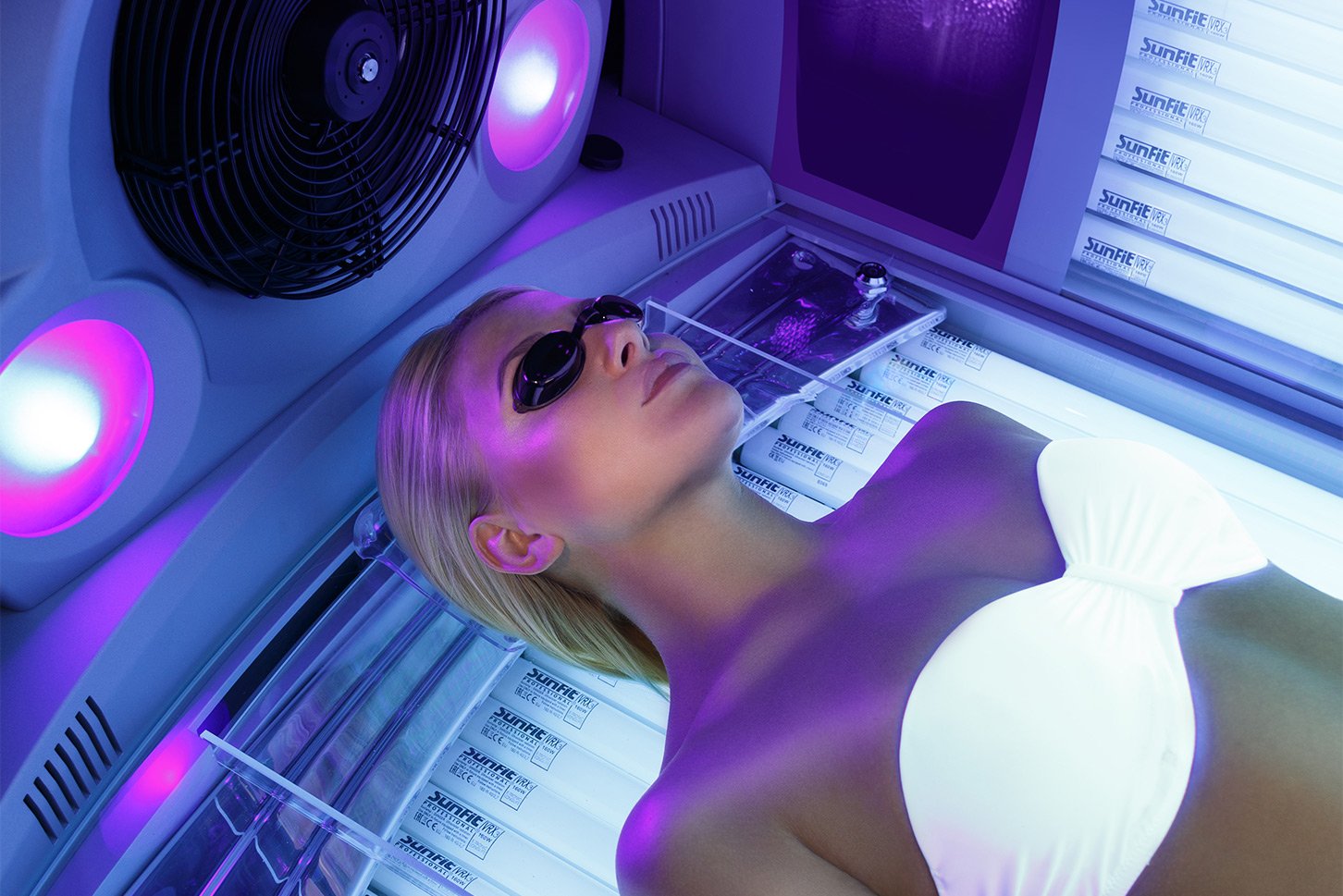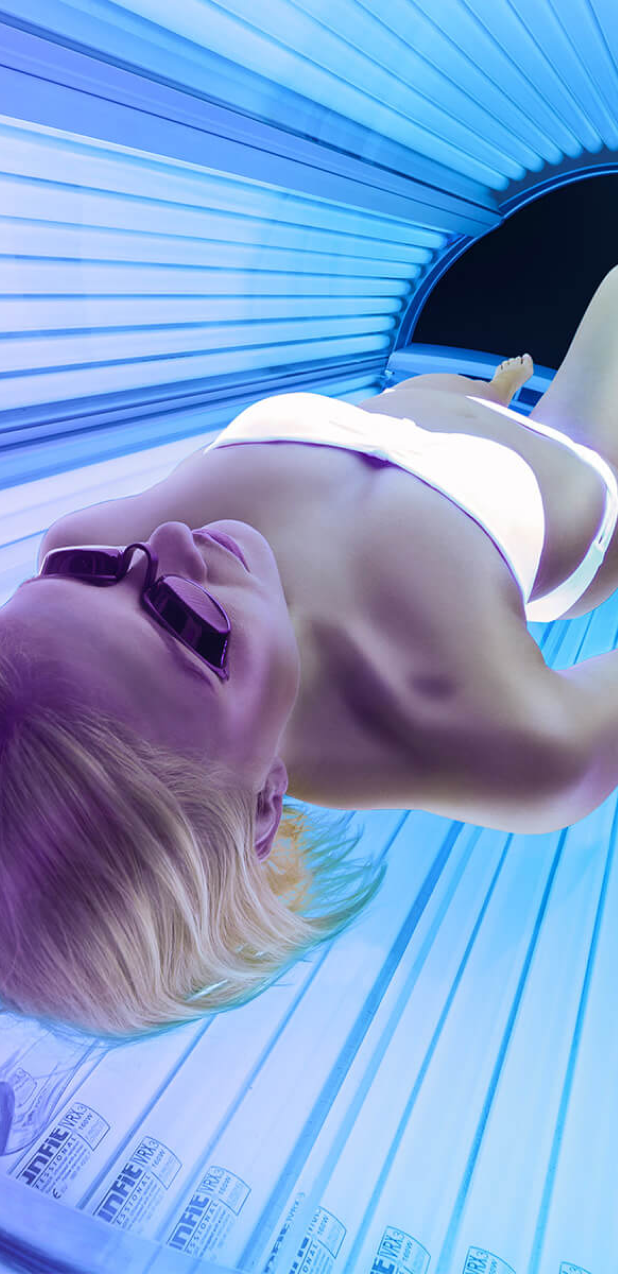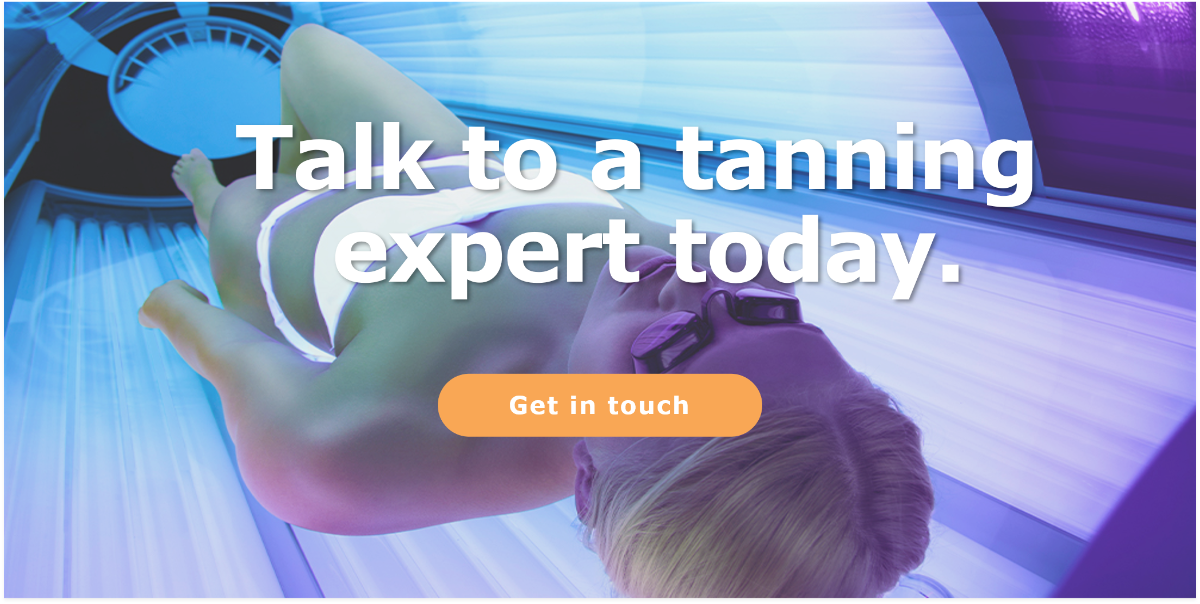Using Sunbeds to Improve Your Mental Health – What to know
Sunbeds ensure a glowing tan 365 days of the year. But these devices that emit UV light have other benefits besides cosmetic, such as boosting vitamin D levels and treating seasonal affective disorder (SAD).
If used correctly, sunbeds can have a great positive impact on not just our looks but on our mood as well. In this article, we’ll cover the science behind sunshine and happiness and how you can use sunbeds to mimic the results the sun offers. We’ll cover the time we need to spend in sunlight, the benefits UV light has on humans and how to use them safely.
How much sun do we need?
Holick (2004) states that a reasonable amount of sun exposure can produce a fair amount of vitamin D for 5 – 10 minutes and 2 – 3 weeks. However, your body breaks it down quite quickly. Therefore, your supply can run low especially during the winter months.
The sun emits UV radiation: UVA, UVB and UVC. The Earth's atmosphere blocks the latter from reaching the surface. As a result, living organisms only absorb UVA and UVB light. The former is responsible for that direct, intensive and attractive tan. At the same time UVB boosts vitamin D, improving your immune system and surprisingly your mood too.
That's where sunbeds come into play. Tanning devices emit UV light in a controlled environment, delivering the same benefits as the sun. As a result, leading to an increase in serotonin — a hormone that is responsible for regulating your mood, appetite and sleep — helps stave off SAD. Moreover, sunbeds can also help people with stress, anxiety and depression.
The potential benefits of sunbeds for mental health
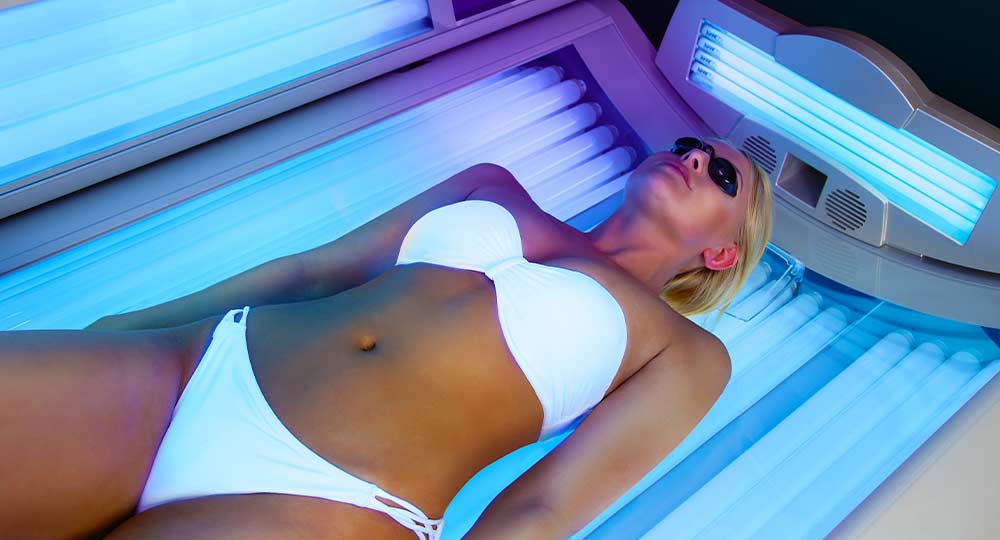
Indoor tanning machines offer the same benefits as the midday Mediterranean sun but in a controlled environment: boost vitamin D production (Holick, 2010).
Because of its structure, vitamin D helps other hormones do their job. For example, it helps the body to absorb calcium, magnesium, and iron (Kaushal et al., 2013). It's fundamental role comes when our body converts it into vitamin D3 leading to various physical and mental benefits.
Sunbeds can help you boost immune system
It’s an old wives’ tale that when you’re under the weather you should take vitamin C. But vitamin D can boost your immune system too. Accordingly, it can also reduce the chances of getting the flu (Urashima et al., 2010).
Moreover, vitamin D helps prevent several autoimmune diseases by regulating inflamed immunological functions by encouraging the production of white blood cells an boosting your immune system.
Sunbeds can help you treat SAD
Besides helping when we’re physically ill, vitamin D can also be helpful when it comes to our mood. Researchers found that people with depression who receive a boost in vitamin D noticed an improvement in their symptoms.
In another study about fibromyalgia, researchers found vitamin D deficiency was more common in those who were also experiencing anxiety and depression (Makrani et al., 2017).
In the winter months, many people tend to experience seasonal affective disorder — a kind of depression characterized by unfavourable mood swings caused by seasonal fluctuations. That’s because the cold and cloudy weather affects your natural Vitamin D intake.
Sunbeds are great for stress relief
Exposure to sunlight reduces the release of adrenaline and noradrenaline in the body reducing overall stress levels. Going on holiday to a sunny climate can help, although this option is not always available for some.
Responsible use of sunbeds may increase the production of endorphins, a group of “happy hormones” manufactured in the brain and released in the body elevating your mood. The temporary feeling of calm and relaxed could help to relieve stress levels.
Moreover, a study by Heckman et al. (2016) indicates that indoor tanning is associated with decreased negative mood and anxiety.
The science behind the sun and our moods

Sunlight has a profound impact on our mood. It is undeniable that the sun has a powerful effect on our physical and emotional well-being. When exposed to sunlight our bodies create vitamin D which is vital for our general health. Vitamin D aids our bodies' calcium absorption which is required for strong bones and teeth. It also helps regulate our immune system and reduces inflammation.
In addition to the physical benefits, sunshine has a sizeable effect on our mood. Sunlight causes the release of serotonin. Decreased levels of this hormone has been linked to depression, anxiety and SAD.
Spending time outside in the sun also provides an opportunity to engage in physical activity which is important for maintaining a healthy body and mind. When we combine exercise with sunshine we get a powerful mood-boosting combination.
The sun plays a vital role in our mental health. It provides essential vitamins and hormones that regulate your mood and overall well-being. While protecting yourself from overexposure is important, spending time in the sun can do wonders for your mental health especially during the dark winter months.
Unfortunately, we don't live in a perfect world where we would have the time and opportunity to bask in the sun and make enough vitamin D. Luckily, sunbeds are a viable alternative to natural sunlight (Holick, 2010).
How to safely use sunbeds for mental health and relaxation
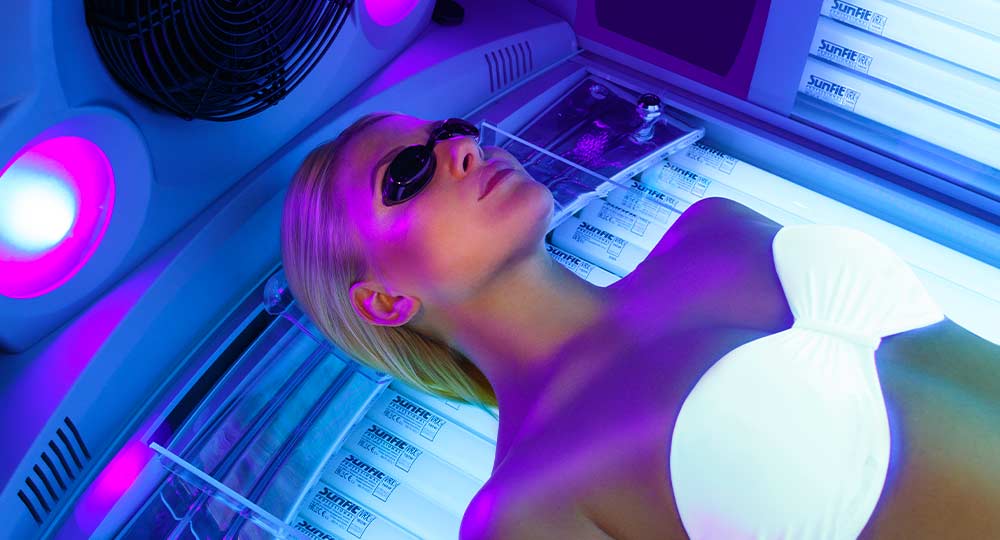
Knowing tanning beds offer many benefits besides looking good sounds promising, but you should use them with care. Luckily, through the quality-control and education efforts of the Sunbed Association more people are using sunbeds responsibly.
The relationship between sunbeds, mental health and body image is quite complex. Luckily, throughout the UK, tanning facilities are regulated by strict rules and guidelines enforced by their respective counties.
Moreover, Ultrasun tanning beds in the UK are classified as 0.3 or 0.3W/m2 — the amount of UV exposure — which is approved by the EU and complies with all British and European consumer safety regulations.
Besides all the provisions, there's one important rule to know beforehand and it counts for all skin types: don't sunburn !
Follow the aesthetician's advice
Always follow the advice and instructions of the salon's staff. These consultants know the ins and outs of how your skin reacts to UV light. Therefore, they can give you valuable information about the sunbed you use.
Do not tan when using medicines
Some medications can increase your sensitivity to UV radiation and lead to sunburn. Some of these medications include but are not limited to:
- Antibiotics
- Diuretics
- Antidepressants
- Drugs for blood pressure
- Antimalarials
- Some Analgesics (in treatment for Rheumatism & Arthritis)
- Some Contraceptive pills
- Psoralens (for Psoriasis)
- Eosin (Lipstick)
Conditions such as Diabetes, Epilepsy, Migraine and Asthma may be affected by the sunbed's UV radiation.
Nevertheless, always consult your doctor when you're taking medication or your dermatologist to check if it's ok for you to enjoy indoor tanning.
Never exceed the tanning time
The tanning time depends on your skin type and the types of UV tubes inside the sunbed. It's important to stay within the recommended tanning time to avoid overexposure.
Please ask the salon's attendant if you need clarification on how long your tanning session should take.
Seek professional help
Sunbeds are not a quick solution to mental health problems, despite the temporary mood-boosting effects of UV radiation. While the responsible use of sunbeds may provide a short-term sense of relaxation and happiness, the long-term effects of excessive UV exposure can have severe consequences for both physical and mental health.
Additionally, relying on sunbeds as a solution to mental health issues can be a sign of a deeper underlying problem that needs to be addressed through therapy or other forms of treatment. Therefore, seeking professional help rather than relying on sunbeds as a quick fix for mental health issues is important.
Conclusion
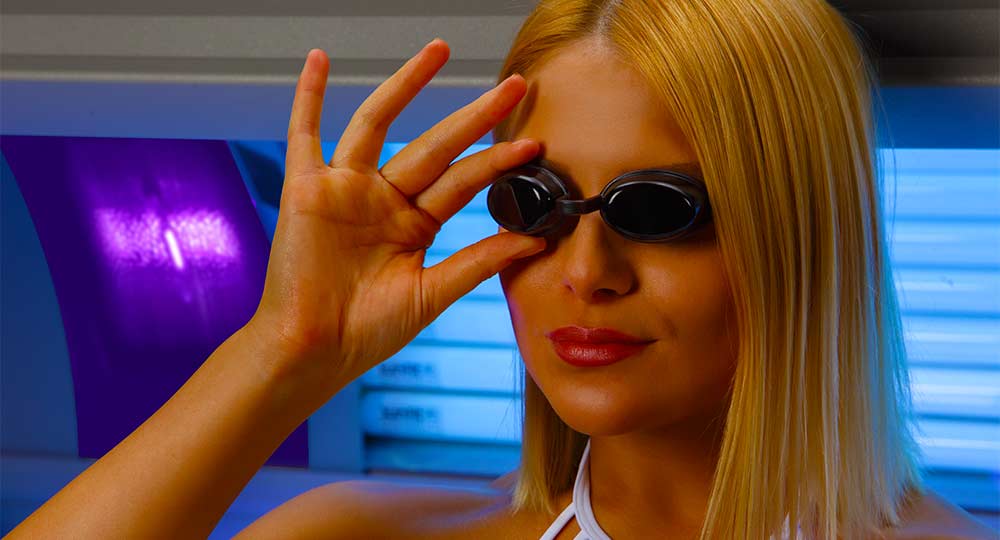
Indoor tanning machines can be a convenient way to achieve a tan and stimulate vitamin D production, which can benefit people both physically and psychologically.
Studies on the impact of sunbeds on mental health during the winter months suggest that tanning devices can alleviate – in short term – stress and anxiety and improve your mood. Further research is still needed to fully understand the relationship between sunbeds, mental health and body image.
If you're concerned about your mental health, speaking to a healthcare professional for guidance and support is always best.
FAQs about sunbeds and mental health
Does vitamin D help with mental health?
According to several studies, a vitamin D boost can address various mental health issues such as stress, anxiety and seasonal affective disorder.
Do sunbeds help you make vitamin D?
Yes, sunbeds emit UVB light the same type of UV radiation that triggers vitamin D production in the skin. Please note the amount of UVB from a sunbed is a very small portion of the UV light that is emitted by the device.
Twenty minutes of UV exposure from a sunbed may create the same amount of vitamin D as 30 minutes of natural sunlight exposure.
Do sunbeds improve mental health?
Indoor tanning and its impact on mental health is still a new topic in the research field. But we have found evidence that UV radiation – in short term – can help increase serotonin levels.
Sources
Campbell, P. D., Miller, A. M., & Woesner, M. E. (2017). Bright Light Therapy: Seasonal Affective Disorder and Beyond. The Einstein Journal of Biology and Medicine : EJBM, 32, E13–E25. https://www.ncbi.nlm.nih.gov/pmc/articles/PMC6746555/
Cicarma, E., Porojnicu, A. C., Lagunova, Z., Dahlback, A., Juzeniene, A., & Moan, J. (2009). Sun and Sun Beds: Inducers of Vitamin D and Skin Cancer. Anticancer Research, 29(9), 3495–3500. https://ar.iiarjournals.org/content/29/9/3495
Heckman, C., Darlow, S., Cohen-Filipic, J., & Kloss, J. (2016). Mood changes after indoor tanning among college women: associations with psychiatric/addictive symptoms. Health Psychology Research, 4(1). https://doi.org/10.4081/hpr.2016.5453
Holick, F. M. (2010). The Vitamin D Solution : a Three-step Strategy to Cure Our Most Common Health Problem. Scribe Publications Pty Ltd.
Holick, M. F. (2004). Sunlight and vitamin D for bone health and prevention of autoimmune diseases, cancers, and cardiovascular disease. The American Journal of Clinical Nutrition, 80(6), 1678S1688S. https://doi.org/10.1093/ajcn/80.6.1678s
Kaushal, M., & Magon, N. (2013). Vitamin D in pregnancy: A metabolic outlook. Indian Journal of Endocrinology and Metabolism, 17(1), 76–82. https://doi.org/10.4103/2230-8210.107862
Makrani, A. H., Afshari, M., Ghajar, M., Forooghi, Z., & Moosazadeh, M. (2017). Vitamin D and fibromyalgia: a meta-analysis. The Korean Journal of Pain, 30(4), 250. https://doi.org/10.3344/kjp.2017.30.4.250
Urashima, M., Segawa, T., Okazaki, M., Kurihara, M., Wada, Y., & Ida, H. (2010). Randomized trial of vitamin D supplementation to prevent seasonal influenza A in schoolchildren. The American Journal of Clinical Nutrition, 91(5), 1255–1260. https://doi.org/10.3945/ajcn.2009.29094
Related Articles
